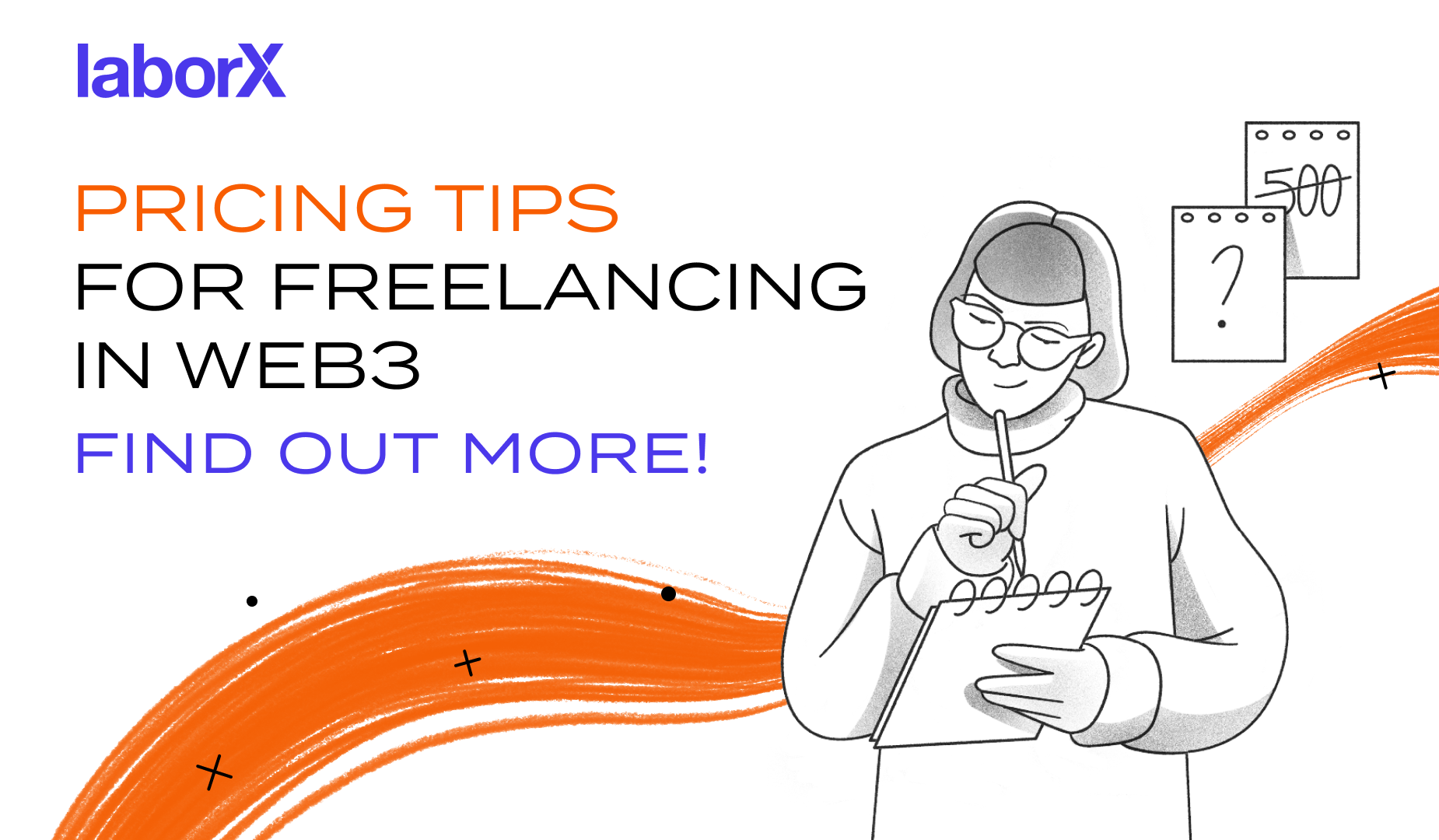
Embracing Change: HR in the World of Digital Assets
Hotcoin’s HR shares her journey from traditional industries to the world of Web3 and crypto, highlighting key insights on thriving in this space.
Read
Setting a fair rate of pay for your work can be one of the hardest aspects of working as a freelancer. There are lots of reasons why this is the case – some practical, some more emotional. We will cover a lot of them in greater detail, so sit back & go through this definitive guide along with salary benchmarks.
Figuring out what your work is worth is something many freelancers struggle with – and that’s before you come to broaching the subject of discussing your rates with your clients.
Setting a fair rate of pay for your work can be one of the hardest aspects of working as a freelancer. There are lots of reasons why this is the case – some practical, some more emotional. Some of the factors involved and the questions you might ask yourself could include:
In the blockchain industry, it can be even harder to decide on a fair price, again for various reasons. The sector is still relatively new, and growing fast, and there’s a wide range of different projects that might be hiring, each with their own budgets and priorities. The market is also highly cyclical, with company valuations and pay rates ballooning in the good times, but cost-cutting and lay-offs taking place in the periodic crypto winters. There is also considerable variation in terms of quality of freelancer, with those at the top being in a position to demand many times what less experienced and proficient freelancers charge.
With all that in mind, let’s explore how you can make sure you’re asking a fair price for what you do as a freelancer in the Web3 sector – and take a look at a few examples of popular roles and rates of pay along the way.
In some cases, you won’t get much of a choice in the pay you accept (or not) for taking a job. If you’re browsing for Jobs on freelancer platforms, then the customer will typically set a certain rate and you can take it or leave it; there won’t be much room for negotiation, since if you don’t apply for the job it’s likely that someone else will be willing to take it at that price.
However, platforms like LaborX also allow you to upload Gigs – clearly-defined services that come with a fixed price tag. Customers can browse these and purchase them if they fit their brief and budget. When setting a fee, or pitching to clients more generally as you look for work in the Web3 world, you’ll need a clear idea of what it’s appropriate to charge, so that you can compete favourably with other freelancers in the same category but still ensure you’re paid fairly for your work and experience.
Start out by having a clear idea of what it is you do, and how this contributes to the success of a customer’s organisation. For example, perhaps you’re a social media marketing (SMM) expert, and your work consists of engaging Web3 communities on Twitter, Telegram, Discord, and other platforms. But what does that mean in practice for your client?
If you’re able to quantify your success – for example in terms of followers gained, additional community members, traffic generated, and so on – that’s far more meaningful and compelling. Put together a portfolio of work you have done in the past, including any metrics for the impact you’ve had. (At this point, this is mainly for your benefit, but this will come in handy later when negotiating with customers.)
It’s also important that you figure out where you fall in the spectrum of quality. There will likely be a lot of people doing the same job that you do. One key difference will be how well you do it in comparison to the competition. Additionally, are there any skills you have or services you offer that others typically don’t? For example, let’s say you’re a content creator. Do you also have experience of SEO, monitoring website traffic analytics and fine-tuning your articles to target the best keywords? That’s certainly something that will differentiate you from others in the same field.
Now that you have a clear idea of what it is you do, it’s time to look at who else is doing the same and what they’re charging. Depending on your sector and skillset, that might not be straightforward – there might not be anyone to compare yourself to directly.
Start by looking at Gigs and Jobs listings on LaborX and other popular freelancing sites to see what others in your field are charging (and what employers are offering). However, don’t start and finish your search there – the more context and information you can gain, the more you’ll be able to justify the fee you land on.
Look at mainstream jobs sites like LinkedIn and specialist blockchain recruitment sites, as well as company website advertising vacancies directly, for full-time jobs that match what you do. You can then break those salaries down to an hourly rate. (Remember that freelancers typically charge more than full-time employees, due to various factors including a lack of job security and benefits, and the fact that the employer doesn’t have to pay all the fixed costs associated with permanent employees.) Make sure that you find jobs at an equivalent level to your skills. There’s a big difference in pay between a Junior developer and a Senior developer, for example.
If you can’t find jobs within the blockchain sector to use as a reference point, then you can look around for similar roles in the regular tech sector. As a rule, rates of pay in the Web3 space are typically around 15-20% higher than in comparable roles in other sectors, so don’t forget to add a bit of a premium.
Finally, don’t be afraid to make use of any contacts you might have in the industry. Reach out and ask what they charge as a freelancer, whether they or their companies use freelancers, and what the standard rates currently are.
Once you’ve gathered all the information you can, you can fix a price for your services. When you’re starting out, the temptation is often to underprice your work to ensure you receive more offers. That can be a mistake.
Price signals quality, and if you are charging an unusually low rate, customers may assume you’re in a lower tier of expertise – basically they will just assume that you can’t charge more because you’re not good enough. The trick is finding a balance: pick a price that is competitive, but without undercutting other freelancers to the point where customers won’t consider you as a peer to them.
Ideally, you will find a way to compete on more than price. If you can find a unique selling point – excellent communication, some high-profile clients, great testimonials, and so on – that will make you stand out from the crowd within your given price bracket.
There can be a lot of legwork involved in finding the right rates as a freelancer, but there are sites that can give you very useful guidelines. As a starting point, you might be interested to know that the average crypto salary globally is over $90,000. Of course, this varies considerably according to the role, with engineering jobs fetching much more. Below we have listed some popular developer jobs and their average pay (the range varies considerably), plus some non-engineering roles, and extrapolated an hourly freelance rate from them assuming 250 days per year, 8 hours per day, adding a 50% premium for freelancing (which could be considered conservative).
Note: f/t stands for full-time average annualized salary.
If you’ve been freelancing for a while, there’s a good chance you will want to raise your rates from time to time. There can be various reasons for that, not least that as you gain more experience and learn new skills, your work is worth more. At the moment, however, one of the biggest factors will be inflation, which is running at 8-10% in many countries – meaning that pay is on everyone’s minds.
If you’re picking up new clients, then that’s no problem: you can just quote your preferred rate, which should be in line with market norms. For existing clients, though, there will need to be a conversation around the change, which can be awkward. Here are some tips for how to go about doing it.
If you’ve not changed your prices for a while – or perhaps have never gone through the process of researching what they could and should be – then you might be surprised at what you could be charging. It’s worth going through the steps above to reset your fees, starting from scratch and ideally without any preconceived ideas.
Remember also that the blockchain space moves fast. We may just have had a year of crypto winter, but there’s still a lot of excitement about the technology, lots of investment, and a shortage of qualified experts, so resist the temptation to underprice your services (or even lower your prices, unless it really is necessary).
Finally, consider going through this process regularly and updating your prices every year rather than in bigger increments every few years. Apart from being less of a shock to your clients, it will get them used to this being part of how you work.
In preparation for a conversation with your clients about your fees, put together information that will help justify the increase. This might include:
The last point is particularly relevant in crypto, due to the relatively young nature of the industry. If you’ve been around even three or four years (let alone eight or ten), you might be one of the more experienced freelancers in your field. There’s a depth of knowledge that should come with that kind of track record that can’t be gained quickly by someone with less time under their belt.
If you’re still not sure whether your new fees will be accepted, start by trying them out with just one client. If it’s a new client, so much the better – if they simply refuse your rates, you can negotiate if you choose to. If it’s one of your existing clients, then write a short message explaining what your new rates are, why you’re increasing them, and what you have delivered for the client in the time you’ve been working for them.
Bear in mind that some clients just won’t have the budget to hire you, and if that’s the case then it’s best to move on. There is huge variation in what businesses are prepared to pay, and freelancers are prepared to accept, and a sum that is reasonable for one person can sound ridiculously low to another. Rates at the top end can (quite literally) be a hundred times higher than at the lowest end. Quality at the low end is typically terrible, but there is still a market for it.
If one client accepts your new fees, there’s a good chance others will too. Good luck!
Do:
Don’t:

Hotcoin’s HR shares her journey from traditional industries to the world of Web3 and crypto, highlighting key insights on thriving in this space.
Read
Discover how Web3 is reshaping HR practices with insights from a leading expert in the field.
Read
Discover Base's innovative L2 solution addressing scalability, security, and user experience challenges in crypto. Learn about Base Incubator by LaborX, fostering growth and innovation within the Base ecosystem.
Read